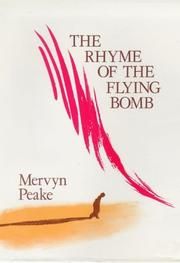The Rhyme of the Flying Bomb is a narrative poem written by Mervyn Peake in 1947, and published with his felt-pen illustrations in 1962.
A sailor wandering in London during a World War II air-raid finds a new-born baby in the debris. He takes refuge with the child in an empty church, where it amazes him by levitating and speaking. A dialogue follows between the child, fresh from eternity, and the man mired in the temporal world. At dawn a flying bomb falls on the church, killing them both.
The poem was set to music by Tristram Cary in 1964 in an arrangement for piano, woodwinds, percussion and tape with two spoken parts. It was broadcast by the Australian Broadcasting Commission in 1976 with Barbara West, Alan Hodgson and musicians conducted by the composer.
Reill 253. Mervyn Peake was born in Kuling, China, the son of a missionary doctor. He attended Tientsin Grammar School and, on his family's return to England, Eltham College in Kent; subsequently he trained at the Croydon School of Art, and 1929-33 at the Royal Academy Schools.
In 1936 he was commissioned to design the sets and costumes for the 'Insect Play', and began teaching Life drawing at Westminster School of Art where he met Maeve Gilmour.
In 1940 Peake applied to work as a war artist, but was refused, and was called up to the army. In 1942 he suffered a nervous breakdown, and was subsequently invalided out of the army. At the end of World War II he visited Belsen with journalist Tom Pocock, to act as an illustrator for a report for a periodical. He produced many drawings, but found the experience harrowing.
At the outbreak of World War II he applied to become a war artist for he was keen to put his skills at the service of his country. He imagined An Exhibition by the Artist, Adolf Hitler, in which horrific images of war with ironic titles were offered as 'artworks' by the Nazi leader. Although the drawings were bought by the British Ministry of Information his application was turned down and he was conscripted in the Army, where he served first with the Royal Artillery, then with the Royal Engineers. The Army didn't know what to do with him. He began writing Titus Groan at this time.
In April 1942, after his requests for commissions as a war artist - or even leave to depict war damage in London - had been consistently refused, he suffered a nervous breakdown and was sent to Southport Hospital. That autumn he was taken on as a graphic artist by the Ministry of Information for a period of six months. The next spring he was invalided out of the Army. In 1943 he was commissioned by the War Artists Advisory Committee to paint glassblowers at a Birmingham factory making cathode ray tubes for the early radar sets.
He continued to write and paint, having completed (amongst many other works) 'Titus Groan' and 'Gormenghast', until he developed Parkinson's disease at the age of 46. 'Titus Alone' was written during the first part of his final illness, and although it was completed, it was left in an unedited state. A version was published in 1959, based on his manuscripts, and a revised version was printed in the UK in 1970, edited by Langdon Jones.
His reputation as an author is based on the three Titus novels: Titus Groan (1946), Gormenghast (1950), and Titus Alone (1959; revised edition edited by Langdon Jones, 1970).
His other work includes the novel Mr Pye (televised by the BBC in the 1980s, with Derek Jacobi in the title role), the children's story Captain Slaughterboard Drops Anchor (which he also illustrated), and illustrations for Treasure Island and The Hunting of the Snark.
